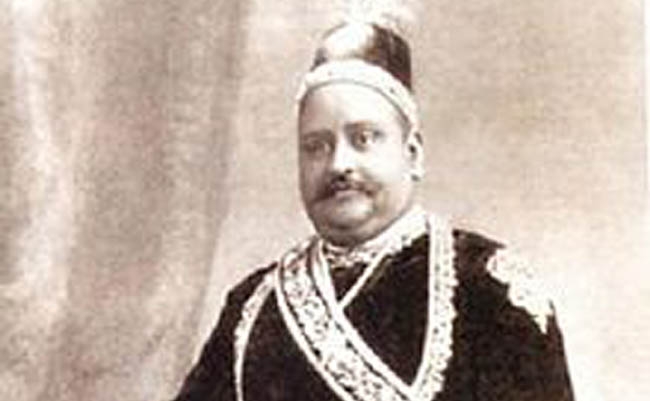By Syed Nasrul Ahsan
Khwaja Salimullah, Nawab of Dhaka, Muslim nationalist, an architect of the All Indian Muslim League, was born at the Ahsan Manzil on 7th June, 1871.
He was the son of Nawab Khwaja Ahsanullah and grandson of Nawab Khwaja Abdul Ghani. He was a patron of education and learnt Urdu, Arabic, Persian and English at home.
He entered government service as a Deputy Magistrate in 1893, but left the job of Magistrate in 1895. Then he started business. After his father’s death in 1901, Salimullah, as the eldest surviving son, become the head of the Dhaka Nawab estate and inherited the hereditary title “Nawab”. His name is still a house hold word in Bangladesh.
Nawab Salimullah got involved in politics in 1903-1904 by the way of giving opinion on the government’s plan for the partition of Bengal. His contribution to Muslim politics in India was most noteworthy. It was he who was called upon to move the first Resolution at the inaugural Session of the All India Muslim League held in Dhaka on 30 December 1906.
Nawab Salimullah was a philanthropic person. He used to contribute generously to socio-economic Development activities. He donated in 1902 one lakh twelve thousand rupees that had been promised by his father for the establishment of Dhaka Engineering School, now Bangladesh University of Engineering and Technology (BUET). He patronized projects in the agricultural and industrial sectors; and also for the construction of mosques, madrasas, hospital, and student dormitories as well as other works of social upliftment. He used to arrange exhibitions to promote development of Dhaka handicrafts. His efforts gave this industry a new life. He was a member of the committee formed by the East Bengal Government in 1909 in order to promote development of handicrafts.
On October 16, 1905, it is purely only for administrative reason the vast Bengal presidency was bifurcated and set up a new province of East Bengal and Assam to benefit the poor people of East Bengal. It is in the interest of the staggering poor people of East Bengal Nawab Salimullah came out to welcome the decision of setting up a new province. Dhaka after long time became the capital of the new province and took a new look. After this decision, number of students in schools and colleges increased by 35%. Unfortunately this was not tolerated by the Hindu elite people who collected taxes from the downtrodden poor people of East Bengal residing in Calcutta led life in lavish luxury. They started a movement against this decision of the new province. This movement ultimately turned into terrorism. The decision was annulled on 12 December, 1911.The people of East Bengal especially Muslims became frustrated. Nawab Salimullah became dissatisfied.
The frustrated Nawab convened a meeting of the then Muslim leaders of East Bengal and wrote two letters on 17th and 20th December 1911. Post annulment agonies of the Muslims of East Bengal were ventilated and he suggested setting up a university in Dhaka. The two letters are still preserved in the library of Cambridge University. On the basis of two letters and after long discussion consultation commissioning British Government set up the Dhaka University. It is definitely out of pressure, request, counseling and exchange of letters that the British government yielded to the demand and the dream of the Nawab. Dhaka University was established in 1921.
As a token of respect and gratitude the first residential Hall of Dhaka University was named after the Nawab as Salimullah Muslim Hall. He donated land for the university and High Court in Dhaka. The greatest achievement of Nawab was the foundation of All India Muslim League. It was one the first phase of the execution of new province he convened an All India Muslim Educational conference on 27th December 1906. Not less than 800 representative attended the conference from all over the sub-continent. It is with high exuberance and ecstasy the delegates gathered from all parts if India. Nawab Salimullah was the chair of the reception committee. Justice Sharif Uddin of Calcutta High Court presided over the conference. The political session was held on 30th December, 1906. Nawab Waqar-ul-Mulk presided over the political session. O the proposition of Nawab Salimullah and supported by Hakim Afzal Khan, Age Khan was elected president. Nawab Salimullah was elected vice president while Mohsin-ul-Mulk and Nawab Waqar-ul-Mulk were elected joint secretariesrespectively. He defrayed all the expenses (not less than six lactaka) from his Nawab family fund.
Although Nawab Salimullah was the host and sponsor of the conference he did not take the leadership of the newly formed Muslim League. It means he had no ambition of greed for leadership. His purpose was to unite the Muslim of the sub-continent and change their lot. This Muslim League after working year after year has been able to unite the Muslim of the subcontinent and with 41 years gave birth to a separate Muslim homeland Pakistan. Later on eastern wing got independence from western wing named Bangladesh. His dream was fulfilled but he could not see the reality.
Nawab Salimullah was a member of East Bengal and Assam Legislative Assembly (1906-12) and of the Imperial Council and also of the United Bengal Legislative Assembly (1913-15). The British government conferred on him the titles of CIS (1902), Nawab Bahadur (1903), KCSI (1909), and GCSI (1911). Personally he was honest, courageous and pious. He established a night school at Dhaka, development the panchayet system of the city, and popularized the observance of Miladunnabi and Fateha-i-Doaz Daham. He incurred heavy debts due to unlimited expenditure for public welfare works and politics.
After the annulment of the partition of Bengal, Salimullah was struck with a deep sense of disappointment and fell seriously ill. He died on 16 January 1915 in his house at Chaurangi, Calcutta. His body was brought to Dhaka in state honor and was buried in the family graveyard at Bengal weeping forever.
Nawab Salimullah Bahadur as one of the prime founder members of the Muslim League Lighted a candle that burnt undimmed till the dream of Muslim renascence found its fullest and most concrete expression in the birth of Pakistan.





